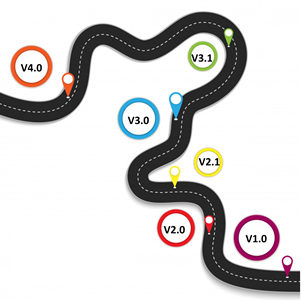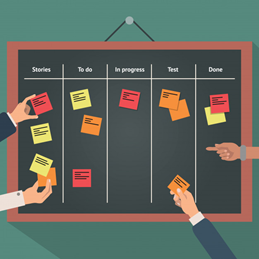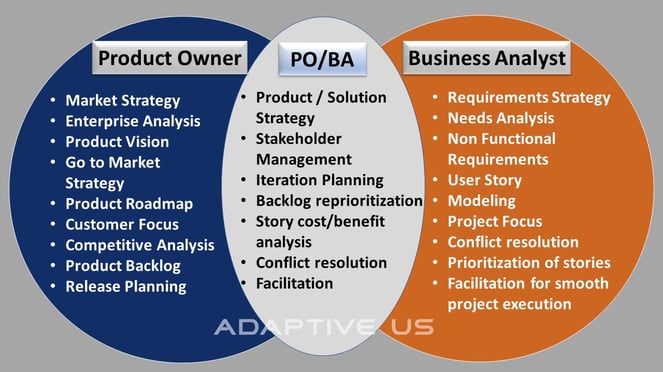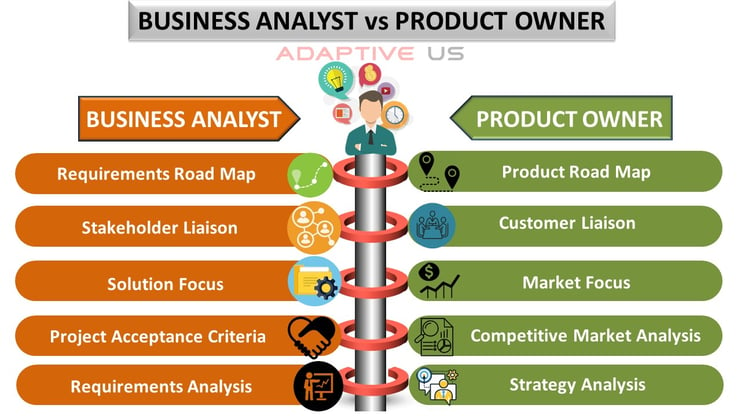Agile projects due to the short cycles of delivery, require much higher collaboration, better leadership support and a strong agile culture to be in place to be called as working and successful. In this context, the two key roles responsible for conceptualizing a great product/app/solution and delivering it well are the Product Owner (PO) and the Business Analyst (BA). However, there exists a lot of ambiguities between these two roles. Let us look at both the roles to seek similarities and differences.
Product Owner
The product owner is like the director of a movie. He / She has a vision of the product keeping the domain/industry experience and the market need in mind.
His/her job is to ensure that the product meets the market and stakeholder needs, he/she conducts market analysis followed by an enterprise SWOT analysis to come up with the product vision. The PO also works on the go to market strategy for the product.
The product owner tries to leverage his/her experience / expertise in the domain, need of the market, the industry or the domain that it is into, the organization’s market position and the customer expectation of the product as seen over the years of experience.
Key Activities for Product Owner
-
Market Analysis
This is where the product owner analyzes the market need/demand and the availability of products in the market in the domain/focus area concerned. Market analysis can indicate customer needs or segments which are under served, gaps in the market, potential trends to observe and synergies with the current product offerings etc.
-
Enterprise Analysis
This is where the product owner does an enterprise level analysis of the organization’s strengths, weaknesses, market offerings, market positions, due diligence on the market opportunity to determine whether it’s a worth the effort for the organization to pursue.
-
Product vision and roadmap
The industry and domain knowledge / experience helps the product owner to understand the market expectation + need and from that emerges the product vision. He / She has a mental picture of the product based on which he / she comes up with a product road map, a high-level overview of the need that the product will meet, timeline of the launch, its future releases over a period of time,

This is something very crucial since the product timeline, backlog and release planning happens based on this.
-
Go to Market Strategy
The product is of no use if it doesn’t become successful in the market, hence the go to market strategy is as essential as the product and hence needs to be well thought of and worked out. This task is owned by the product owner along with the marketing, sales and communication team. Since the PO has seen the market need, has come up with the product vision and worked out the features of the product, it is the essential for him / her to work out the marketing messages, channels of sales, communication, advertising modes etc.

-
Managing Product features
-
Managing stakeholder expectations and prioritizing their needs
This is the stage where the product owner prioritizes the product features based on the product vision, stakeholders’ expectations and the road map. The stakeholders needs and the market needs are analyzed and the prioritization is done based on the investment needed, criticality of the feature and the ROI expected. In short here the epics are planned.
-

This is where the PO works closely with the stakeholders and the BA in giving more details to the product.
-
Managing Product backlog
This is one of the critical tasks of the product owner. A well-planned product backlog not only makes the sprint, iteration and release planning easier, but also delivers happiness to the stakeholders. Here the team formation and the work planning also is taken up. The product backlog uses prioritization for the stories based on the ROI analysis and criticality of the features.
-
Managing overall iteration progress
The product owner reviews each iteration to ensure that the right prioritization is made in terms of planning the stories in the iteration. The PO also reviews the iteration after its over to ensure that the feedback and learnings from the past iteration are incorporated in the next one. There may be changes to the original plan based on customer needs, market changes, or new requirements/regulations etc. The PO works closely with the BA for impact analysis if there is a change in the prioritization or if there is a new requirement that comes up.
Business Analyst
Business analysts as we know are change makers, problem solvers, the questioning and solution guys, facilitators, bridge between the users/stakeholders and the agile team. They work closely with the product owners to manage the user stories and epics. They question assumptions and requirements, assess the needs, find gaps, they work closely with the stakeholders/SMEs to detail the requirements/features /user stories and understanding / elicitation of the requirements.
On the other hand, they also work closely with the team to ensure that the requirements are understood correctly and implemented in the right manner. They also ensure that the features/requirements are working as expected before being delivered to the users. They are often closely involved in UAT before the product is delivered to the users. An effective business analyst in the team is like the connecting link/bridge between all the involved parties and makes sure that things are in order and working as per plan. An enthusiastic BA ensure that there are no last-minute surprises, hiccups for the delivery/release. The BA is also responsible for maintaining the traceability and conduct the impact analysis when a change comes up.
The Business analyst role supports the Product Owner in delivering detailed artifacts. In-fact, we often consider the business analyst as a proxy product owner. This allows the agile team to have higher amount of access to product owner’s perspectives.
Key Activities for Business Analyst
-
Managing User stories
Prioritizing the user stories as per the needs of the stakeholders and the product roadmap is one of the key responsibilities of the BA. This helps in setting the right speed for the product/solution delivery.

-
Detailing the requirements as per the stakeholders’ needs and expectations
The BA leads the requirements detailing, requirements walk throughs and workshop sessions as part of the story detailing phase. BA is responsible for the requirements elicitation and documentation as well as the non-functional requirements also. The BA puts up the models and the data flows highlighting the business rules. Adding the business rules and acceptance criteria is some of the key tasks taken up by the BA as well.

-
Clarifying the details of requirements with stakeholders
The requirements elicitation as well as the detailing is one of the primary responsibilities of the BA which involves frequent interactions with the stakeholders for their inputs.
-
Coordinating with the development team to get the stories developed
The BA is almost the Single Point of Contact (SPOC) in the project for the team to get all their questions answered on the functional and non-functional requirements. During sprints they provide day to day support to the agile team in clarifying questions, understanding business rules and dependencies.
-
Impact analysis for changes
The BA is responsible for maintaining the traceability matrix and the dependencies hence it becomes his/her responsibility in conducting the impact analysis whenever there is a change that comes in the story or requirements. The dependencies mapping is key to come up with the impact analysis and the components affected.
-
Work closely with the PO on the sprint execution
The BA acts as the representative of the PO in the agile team in clarifying questions and issues. He/she plays a key role in assisting the PO in the sprint management, user stories, managing Epics, product backlog, developing the models highlighting the business rules, data flows, etc. A great collaborative team of the BA and PO together is crucial for the project success. The iterative process of development, testing and multiple walk-though sessions with the stakeholders / users helps the BA to iron out issues in the preliminary stage.
-
Take a lead role in the sprint retrospectives
The sprint is never complete till the retrospective meeting is conducted and the learnings noted. This is where all the good and not so good points of the sprint is discussed and documented. This is the starting point for the next sprint and the BA is the owner of this to ensure that the learnings are applied in the next sprint.
Final Thoughts
As we find, there is indeed a good amount of overlap of skills and responsibilities between the two roles, however as the name indicates a Product owner works like an owner of the product, envisioning almost every details of the product and the ways to make it market ready. And on the other hand, the BA gives colors to the vision and makes it a reality. Yeah, but the lines are somewhat blurred at places. Here is a simple Venn diagram depicting the tasks/responsibilities and the skills involved for both the roles.

Won’t you laugh at me if I say a good collaboration or teamwork is like a happy marriage where things run smoothly, the needs are taken care of without stressing on it and happiness is delivered.
The same thing applies in an agile team, between the PO and the BA role. They are required to work closely to push it to a successful release to the market.
We can’t stress enough on how important it is to have a clear set of requirements and a well-defined problem to be solved. A well understood and well-defined problem means half the job the done.
Like all other partnerships this also becomes successful with a close collaboration between the BA and the PO. The better the two roles collaborate the better value delivered and better managed the agile team and the sprint is.

Overall, it’s the collaborative effort of a team that makes it a winning one.
Having a PO with good domain knowledge helps in putting across the right features as per the product road map and a proficient BA helps in great sprint execution and perfect collaboration between the numerous stakeholders and the agile team.
In short, the PO manages the bigger picture of the market expectations and the product, the BA manages the close monitoring and executions of the sprint thereby delivering great products and building winning teams. The result is a winner product and a happy and successful agile team.
You May Also Like
These Related Stories

Business Analyst vs. Product Owner Key Similarities and Differences
.jpg)
5 Steps to Become a Product Owner from a Business Analyst




Comments (2)